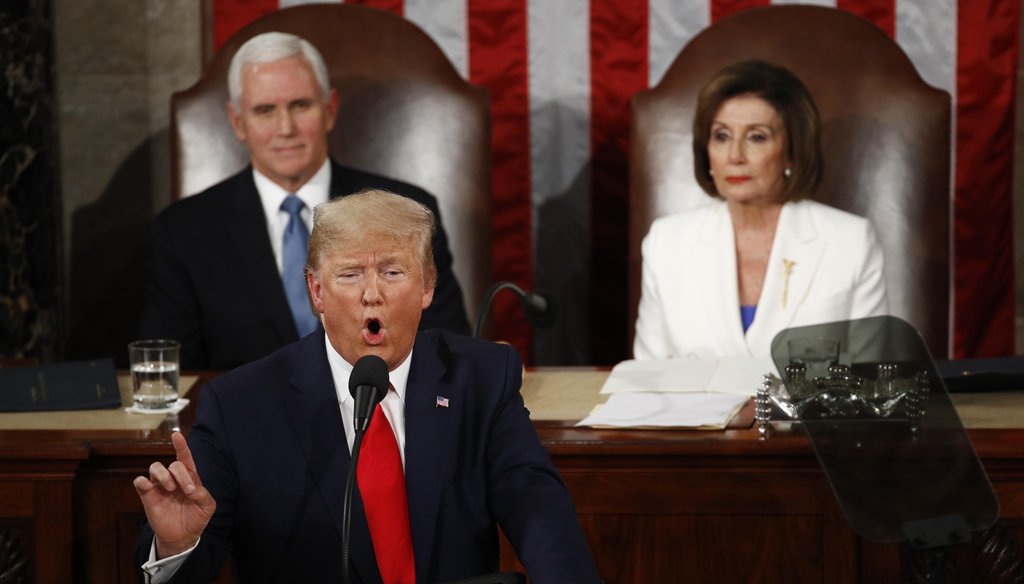

Our only agenda is to publish the truth so you can be an informed participant in democracy.
We need your help.


President Donald Trump delivers his State of the Union address to a joint session of Congress on Capitol Hill in Washington on Feb. 4, 2020, as Vice President Mike Pence and House Speaker Nancy Pelosi, D-Calif., watch. (AP)
In 2018, Congress approved a historic increase of $2.37 billion for the Child Care and Development Block Grant for low-income families.
Trump, who originally proposed cutting the program by $95 million, signed the increase into law.
Congress boosted the program by about $550 million in the 2020 appropriations bill.
Several states said they would use the increase to serve children on the waitlist.
President Donald Trump told Congress during his State of the Union address that under his watch the federal government has achieved record spending on child care.
"I have also overseen historic funding increases for high-quality child care, enabling 17 states to help more children, many of which have reduced or eliminated their waitlists altogether," he said Feb. 4.
We asked the White House to provide evidence but did not get a response. Trump was likely referring to the Child Care and Development Block Grant, which he touted in a December 2019 list of his accomplishments.
Trump is correct that he oversaw a historic funding increase. But we don't have complete information on how many children have been removed from wait lists. Experts said Congress gets the credit for passing the increase.
The block grant program that started in 1990 is the largest source of federal funding for child care. The federal government sends money to states to subsidize child care for low-income families. Parents who generally are working or in school pay a small copay. About 1.3 million children received this subsidy in 2018.
Congress included a $2.37 billion increase for the block grants in the fiscal year 2018 omnibus spending bill. It was the largest one-year increase in federal funding for child care in history, according to the Center for Law and Social Policy, an advocacy organization for low-income people.
The low-income day care program has enjoyed bipartisan support, even before the Trump years, said Stephanie Schmit, an analyst at the center.
In his address to Congress, Trump said he had "overseen" the historic increase. But his 2018 budget proposal called for a $95 million decrease in the program compared with actual spending in 2017. Ultimately Congress approved an increase anyway.
Funding remained relatively flat for fiscal year 2019. But in the 2020 appropriations bill, Congress boosted the program by about $550 million.
It’s tricky to determine the precise impact the additional funding had on waiting lists, because the money can be spent over a number of years. But we found two reports that support the idea.
A National Women’s Law Center report found that eight states were using or were planning to use the extra money to serve families on the waiting list. (Those eight states were Arkansas, Florida, Indiana, Louisiana, Mississippi, North Carolina, Pennsylvania and Texas.)
A Government Accountability Office analysis on how states used the money after 2018 found that nearly one-third of surveyed states (16) reported plans to use the new funds to pay for spots for children on wait lists.
Child care advocates say the funding increases are good news, though vast needs remain: Of the children eligible in 2015, only 15% received subsidies, according to a 2019 analysis by the federal government. That percentage is unlikely to change substantially even after the funding increases, said Karen Schulman, an expert at the National Women’s Law Center.
There are likely more eligible families that need care than actually applied, said W. Steven Barnett, senior co-director of the National Institute for Early Education Research at Rutgers University.
‘Waiting lists are the currently eligible people who bothered to sign up to wait, not all of the people eligible and unserved," he said.
Trump said, "I have also overseen historic funding increases for high-quality child care, enabling 17 states to help more children, many of which have reduced or eliminated their waitlists altogether."
Congress passed a historic increase in funding in 2018, and Trump signed it into law. What Trump left out of his remarks is that he proposed a $95 million cut for the grant program that year. (Congress then passed another increase in 2020, which he signed.)
Determining the impact of that increase on waiting lists is murkier. The reports we saw indicated that between eight and 16 states planned to use money for children on waitlists.
We rate this claim Half True.
Factbase, President Donald Trump State of the Union, Feb. 4, 2020
Government Accountability Office, Child care, April 2019
CLASP, Impact of $550 Million CCDBG Funding Increase for States, Jan. 15, 2020
CLASP, Trump Administration Would Cut Child Care and Early Education Investments, May 25, 2017
National Women’s Law Center, Fact sheet, July 2017
National Women’s Law Center, Fact sheet, January 2019
Budget of the U.S. Government, 2018
U.S. Office of the Administration for Children and Families, FY 2017 CCDF ALLOCATIONS (Including redistributed Funds)
U.S. Office of the Administration for Children and Families, FY 2018 Preliminary Data Table 17 - Average Monthly Mean Family Co-payment as a Percent of Family Income
White House, President Donald J. Trump Has Delivered Record Breaking Results For The American People In His First Three Years In Office, Dec. 31, 2019
Telephone interview, Stephanie Schmit, Senior Policy Analyst, Child Care and Early Education at CLASP, Feb. 5, 2020
Telephone interview, Karen Schulman, National Women’s Law Center’s Child Care and Early Learning Research Director, Feb. 5, 2020
Email interview, W. Steven Barnett, senior co-director of the National Institute for Early Education Research at Rutgers University, Feb. 5, 2020
In a world of wild talk and fake news, help us stand up for the facts.
